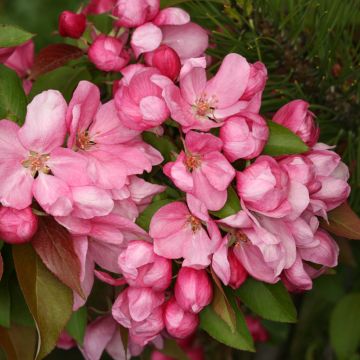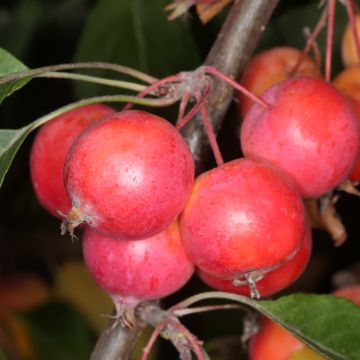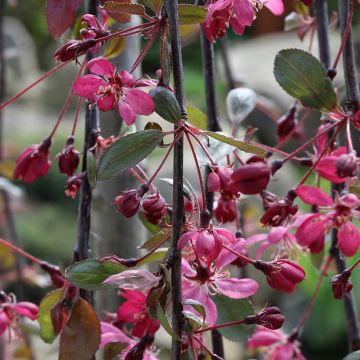

Malus Sugar Tyme - Crab Apple


Malus Sugar Tyme - Crab Apple


Malus Sugar Tyme - Crab Apple


Malus Sugar Tyme - Crab Apple
Malus Sugar Tyme - Crab Apple
Malus Sugar Tyme®
Apple Tree, Crab Apple
Special offer!
Receive a €20 voucher for any order over €90 (excluding delivery costs, credit notes, and plastic-free options)!
1- Add your favorite plants to your cart.
2- Once you have reached €90, confirm your order (you can even choose the delivery date!).
3- As soon as your order is shipped, you will receive an email containing your voucher code, valid for 3 months (90 days).
Your voucher is unique and can only be used once, for any order with a minimum value of €20, excluding delivery costs.
Can be combined with other current offers, non-divisible and non-refundable.
Home or relay delivery (depending on size and destination)
Schedule delivery date,
and select date in basket
This plant carries a 24 months recovery warranty
More information
We guarantee the quality of our plants for a full growing cycle, and will replace at our expense any plant that fails to recover under normal climatic and planting conditions.
Would this plant suit my garden?
Set up your Plantfit profile →
Description
Malus Sugar Tyme is an attractive ornamental crab apple tree. In spring, it is covered with pink buds that open into beautiful single flowers of pure white, with a fragrance. Its young shoots are tender green and at maturity, the leaves take on a darker green hue. In autumn, this Apple tree reveals its second asset in the form of beautiful red fruit, resembling cherries, which persist into winter. It forms a small tree with a fairly spreading habit, well-suited to small gardens. It can be planted individually or in groups.
Ornamental Apple trees are derived from various botanical species of the genus Malus belonging to the Rosaceae family, which also includes fruit-bearing apple trees, as well as most of our fruit trees (Pear trees, Peach trees, Plum trees...). Hardy, adaptable and easy to grow, flowering apple trees, are content with ordinary soil, but prefer fertile, deep, loose and moist soil. Once established, they can be completely forgotten about and will maintain their generous nature. Numerous cultivars have been developed in Europe, as well as in the United States, which are always more attractive and resistant to diseases.
The 'Sugar Tyme' apple tree is an American variety from 1988, introduced to the market by Lake County Nursery, and highly appreciated in the country for its abundant flowering and decorative fruits. It is a small tree with a fairly spreading habit, reaching a maximum height of 5 to 6 m, with a spread of 3 to 4 m. Its young leaves, which appear just before flowering, are tender green and then darken. In April-May, depending on the region, salmon-pink flower buds appear, opening into single flowers, approximately 3.5 cm (1in) in diameter, with 5 petals of pure white, and protruding stamens with yellow tips. These are fragrant and attractive to bees and other pollinators. This particularly abundant flowering covers the entire tree, creating a magnificent spectacle in spring, which is only matched by its autumn fruits. In October, this apple tree bears numerous small spherical fruits, beautiful red in colour, with a size, 12 to 13 mm (1in) in diameter, resembling cherries. These decorative fruits last until winter, creating an interesting scene during this season.
'Sugar Tyme' proves to be highly resistant to diseases, particularly fire blight, with a slight susceptibility to scab. Hardy, it can withstand temperatures down to at least -25°C.
The 'Sugar Tyme' Apple tree is an excellent choice for enhancing a small garden, where it can be planted as a specimen on a lawn or integrated into a border, becoming the centerpiece. Its natural appearance works well with the planting of other similar plants, and even botanical species. Euonymus planipes, a medium-sized shrubby spindle tree with magnificent autumn colours and decorative fruits, is perfect for this role. Another good companion in a natural style is the Amelanchier lamarckii, attractive for three-quarters of the year, with its exuberant white flowers in April, foliage that changes from bronze to green and finally to scarlet red in autumn, and its decorative and edible purple fruits, that make delicious jams. Rosa moyesii Geranium, a botanical rose with beautiful single cherry-red flowers and highly decorative orange fruits in autumn, completes this countryside display.
Malus Sugar Tyme - Crab Apple in pictures








Plant habit
Flowering
Foliage
Botanical data
Malus
Sugar Tyme®
Rosaceae
Apple Tree, Crab Apple
Cultivar or hybrid
Other Malus - Crabapple
View all →Planting and care
Malus Sugar Tyme requires a bright, sunny exposure, and high-quality soil, both deep, loose, rich, and well-drained, remaining slightly moist in summer. It tolerates limestone as well as slightly acidic soils, if rich in humus. Dig a large planting hole. If your soil is poor, dig a nice planting pit, add plenty of good quality humus-rich compost, and apply fertilizer or compost around its base every spring.
After careful planting, accompany with regular watering during the first two years. It will then generally manage on its own, but will suffer in hot and very dry summers. To achieve its full potential, consider its mature size and give it enough space.
This apple tree is known to be highly disease resistant, but may occasionally suffer from scab.
Use nettle manure to strengthen foliage resistance.
Planting period
Intended location
Care
Planting & care advice
This item has not been reviewed yet - be the first to leave a review about it.
Haven't found what you were looking for?
Hardiness is the lowest winter temperature a plant can endure without suffering serious damage or even dying. However, hardiness is affected by location (a sheltered area, such as a patio), protection (winter cover) and soil type (hardiness is improved by well-drained soil).

Photo Sharing Terms & Conditions
In order to encourage gardeners to interact and share their experiences, Promesse de fleurs offers various media enabling content to be uploaded onto its Site - in particular via the ‘Photo sharing’ module.
The User agrees to refrain from:
- Posting any content that is illegal, prejudicial, insulting, racist, inciteful to hatred, revisionist, contrary to public decency, that infringes on privacy or on the privacy rights of third parties, in particular the publicity rights of persons and goods, intellectual property rights, or the right to privacy.
- Submitting content on behalf of a third party;
- Impersonate the identity of a third party and/or publish any personal information about a third party;
In general, the User undertakes to refrain from any unethical behaviour.
All Content (in particular text, comments, files, images, photos, videos, creative works, etc.), which may be subject to property or intellectual property rights, image or other private rights, shall remain the property of the User, subject to the limited rights granted by the terms of the licence granted by Promesse de fleurs as stated below. Users are at liberty to publish or not to publish such Content on the Site, notably via the ‘Photo Sharing’ facility, and accept that this Content shall be made public and freely accessible, notably on the Internet.
Users further acknowledge, undertake to have ,and guarantee that they hold all necessary rights and permissions to publish such material on the Site, in particular with regard to the legislation in force pertaining to any privacy, property, intellectual property, image, or contractual rights, or rights of any other nature. By publishing such Content on the Site, Users acknowledge accepting full liability as publishers of the Content within the meaning of the law, and grant Promesse de fleurs, free of charge, an inclusive, worldwide licence for the said Content for the entire duration of its publication, including all reproduction, representation, up/downloading, displaying, performing, transmission, and storage rights.
Users also grant permission for their name to be linked to the Content and accept that this link may not always be made available.
By engaging in posting material, Users consent to their Content becoming automatically accessible on the Internet, in particular on other sites and/or blogs and/or web pages of the Promesse de fleurs site, including in particular social pages and the Promesse de fleurs catalogue.
Users may secure the removal of entrusted content free of charge by issuing a simple request via our contact form.
The flowering period indicated on our website applies to countries and regions located in USDA zone 8 (France, the United Kingdom, Ireland, the Netherlands, etc.)
It will vary according to where you live:
- In zones 9 to 10 (Italy, Spain, Greece, etc.), flowering will occur about 2 to 4 weeks earlier.
- In zones 6 to 7 (Germany, Poland, Slovenia, and lower mountainous regions), flowering will be delayed by 2 to 3 weeks.
- In zone 5 (Central Europe, Scandinavia), blooming will be delayed by 3 to 5 weeks.
In temperate climates, pruning of spring-flowering shrubs (forsythia, spireas, etc.) should be done just after flowering.
Pruning of summer-flowering shrubs (Indian Lilac, Perovskia, etc.) can be done in winter or spring.
In cold regions as well as with frost-sensitive plants, avoid pruning too early when severe frosts may still occur.
The planting period indicated on our website applies to countries and regions located in USDA zone 8 (France, United Kingdom, Ireland, Netherlands).
It will vary according to where you live:
- In Mediterranean zones (Marseille, Madrid, Milan, etc.), autumn and winter are the best planting periods.
- In continental zones (Strasbourg, Munich, Vienna, etc.), delay planting by 2 to 3 weeks in spring and bring it forward by 2 to 4 weeks in autumn.
- In mountainous regions (the Alps, Pyrenees, Carpathians, etc.), it is best to plant in late spring (May-June) or late summer (August-September).
The harvesting period indicated on our website applies to countries and regions in USDA zone 8 (France, England, Ireland, the Netherlands).
In colder areas (Scandinavia, Poland, Austria...) fruit and vegetable harvests are likely to be delayed by 3-4 weeks.
In warmer areas (Italy, Spain, Greece, etc.), harvesting will probably take place earlier, depending on weather conditions.
The sowing periods indicated on our website apply to countries and regions within USDA Zone 8 (France, UK, Ireland, Netherlands).
In colder areas (Scandinavia, Poland, Austria...), delay any outdoor sowing by 3-4 weeks, or sow under glass.
In warmer climes (Italy, Spain, Greece, etc.), bring outdoor sowing forward by a few weeks.



















































